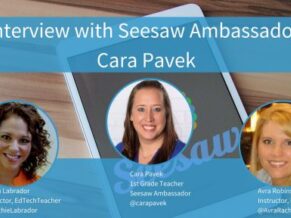Many teachers innately understand that technology should functionally improve students’ learning experiences in order to be considered worthwhile. Conversely, some teachers struggle to discover authentic ways to utilize technology in the elementary classroom. Over the past few years, we have discovered that teachers adapt faster to Seesaw the Learning Journal than many other apps, and quickly discover ways that it can create opportunities for everything from formative assessment to building a community of learners. Students can create and curate artifacts of learning using Seesaw, and teachers can use Seesaw to chronicle that learning over time, as well as connect with family members and a broader audience.
I recently had the pleasure of working with my fellow EdTechTeacher instructor, Anissa Labrador, to interview Cara Pavek - a Seesaw Ambassador and first-grade teacher from Florida - about how she uses Seesaw in her classroom to make assessment more authentic and create new opportunities for home-school connections. Throughout the interview, Cara shared tips for teachers who may want to get started with Seesaw, as well as some of the ways she uses it to chronicle her students’ learning across the curriculum. Cara also described how Seesaw creates a unique ability for her to differentiate learning for her students, as well as how it helps her gain greater insights into her students’ reading abilities.
In the conversation, three interesting topics emerged. First, Anissa and Cara had a fascinating discussion about how Seesaw can prevent student learning artifacts from falling into the depths of the “lost archives.” Seesaw’s capability to sort activities and artifacts by student combines with its teacher-created folder structure to provide a portfolio solution for digital creations. This conversation then segued into a discussion about the advantages that Seesaw provides when it comes to vertical alignment. Since Cara’s school uses Seesaw for Schools, which provides opportunities to view student work across grade levels, teachers can view student work from previous years. As Cara explained, the ability to be able to see student work from Kindergarten has helped her gauge and adjust her own teaching strategies and content.
As an interesting side point, Cara explained that she felt Seesaw helped students to practice Growth Mindset strategies throughout the year. Since they can look back on their earlier work, they have new and unique opportunities to learn and grow.
Finally, Cara explained how her first grade teaching team has begun to integrate the G Suite for EDU products with Seesaw over the past year. While initially seeing the two platforms as mutually exclusive, Cara and her colleagues discovered that Seesaw and G Suite actually work well as a team. In the video, Cara shared a specific example of how her first graders created classroom maps in Google Slides and then imported them into Seesaw for reflection and sharing.
To learn more about these three topics and the rest of the interview, you can watch it below:
https://youtu.be/KECKrnfEbgQ
If you’d like to learn more about Seesaw, join us at our November 5-7 Boston Summit. Rosey McQuillans’ iPads in Elementary pre-conference workshop and Anissa Labrador’s Seesaw session will be great opportunities to learn more and get hands-on with Seesaw. You can also visit Cara’s blog for ideas about Seesaw, G Suite, and more.

